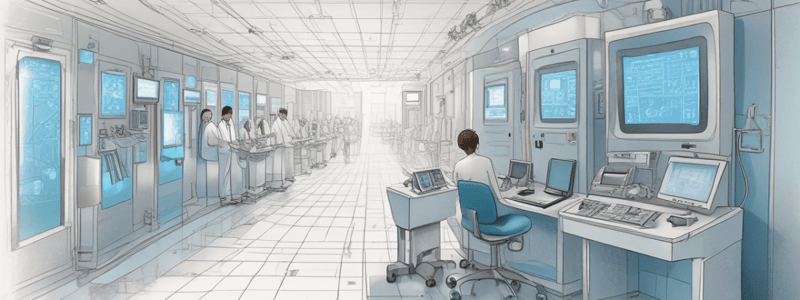Podcast
Questions and Answers
What percentage of the U.S. GDP is spent on healthcare?
What percentage of the U.S. GDP is spent on healthcare?
- 17% (correct)
- 20%
- 10%
- 15%
Which of the following is NOT a role the speaker has had in healthcare?
Which of the following is NOT a role the speaker has had in healthcare?
- Medical school professor (correct)
- Healthcare technology installer
- Hospital CEO
- Physician advisor
What is the approximate adoption rate of electronic health records (EHR) among hospitals?
What is the approximate adoption rate of electronic health records (EHR) among hospitals?
- Over 95% (correct)
- Over 75%
- Over 90%
- Over 50%
Which of the following is NOT a challenge faced by Newark in improving its healthcare indicators?
Which of the following is NOT a challenge faced by Newark in improving its healthcare indicators?
Which of the following is NOT a key healthcare act mentioned in the text?
Which of the following is NOT a key healthcare act mentioned in the text?
What is a major factor contributing to high hospital readmission rates in Newark?
What is a major factor contributing to high hospital readmission rates in Newark?
What is an innovative initiative mentioned in the text to improve healthcare outcomes?
What is an innovative initiative mentioned in the text to improve healthcare outcomes?
What is a key area that needs to align for sustainable healthcare systems?
What is a key area that needs to align for sustainable healthcare systems?
What is a challenge faced by the U.S. healthcare system?
What is a challenge faced by the U.S. healthcare system?
What can help reduce hospital readmissions due to communication gaps?
What can help reduce hospital readmissions due to communication gaps?
Flashcards are hidden until you start studying
Study Notes
- The speaker has a background in healthcare technology innovation, having worked as a physician advisor, installing computer systems for doctor groups, and serving as a hospital CEO.
- They emphasize the importance of technology, business, and clinical needs aligning for sustainable healthcare systems.
- The speaker highlights U.S. healthcare inefficiency, high costs, and lower quality compared to other countries, with 17% of GDP spent on healthcare.
- They mention key healthcare acts like the Medicaid Act of 1965 and the Affordable Care Act of 2010, driving significant changes in healthcare provision.
- The adoption of electronic health records (EHR) has significantly increased among physicians (now around 90%) and hospitals (over 95%) due to incentives and penalties.
- Newark is improving its healthcare indicators but still faces challenges like high hospital readmission rates, especially for conditions like heart failure and pneumonia.
- Communication gaps among healthcare entities lead to readmissions, often due to medication non-adherence and lack of care coordination.
- Solutions involve better data collection, analytics-driven patient care decisions, and patient education for smoother transitions between care phases.
- Innovative initiatives include electronically sharing patient information among hospitals, using analytics to optimize patient care paths, and integrating transportation services for patients.
- Future plans involve developing patient-centered health records that empower individuals to manage and share their health information easily.
Studying That Suits You
Use AI to generate personalized quizzes and flashcards to suit your learning preferences.




